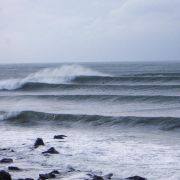As the UK's best known surf beach and birth place of surfing in Britain Fistral has a lot to live up to. The spotlight on Newquay's premiere surf beach has often led to people being dismissive about the actual quality of the waves - don't believe the hype! Fistral really is one of the best beach breaks in Cornwall capable of producing powerful, hollow waves and working under a variety of conditions.
Facing WNW means Fistral picks up a good deal of any north coast swell running. It is also capable of holding it - there are often surfable waves here at 6-8ft and when it gets really huge there's always the Cribbar! As with all beaches the quality of the waves is dependent on the quality of the sand banks. Fistral seems to have fairly consistently good banks.
The beach works through all states of tide, except for Little Fistral (at the northern end) which only really exists at low tide. Little Fistral usually picks up a little more swell than the rest of the beach so can be a good call.
Perhaps the biggest negative aspect of surfing at Fistral is the crowds. As surfing becomes increasingly popular, Newquay and in particular, Fistral, are bearing the brunt of this. On small summer days it's probably a good plan to try somewhere else. It does quieten down a lot in the winter, but not as much as it used to so you'd be pretty lucky to score epic Fistral to yourself.
At the northern end of Fistral in front of Towan head is the Cribbar, Cornwall's legendary big wave spot. Unlike many potential big wave spots around the coast the Cribbar has been surfed, and at over 20ft. Only a handful of surfers have braved the monster that is the Cribbar. The first were Jack Lydgate and visiting Aussie surfers Johnny McIlroy and Pete Russell back in 1966.
Check out our detailed Fistral surf report here.





